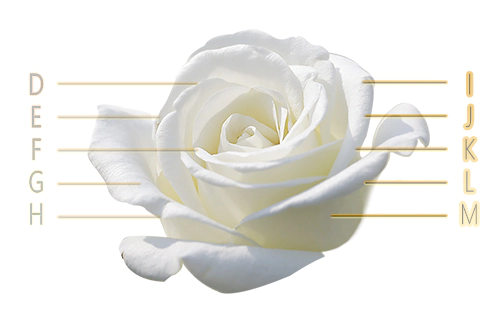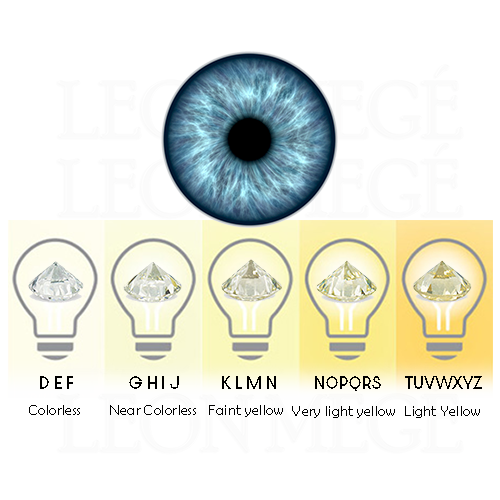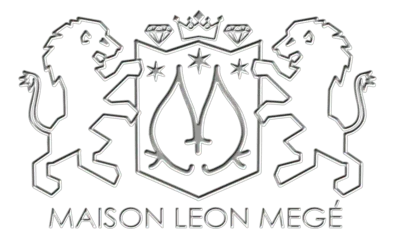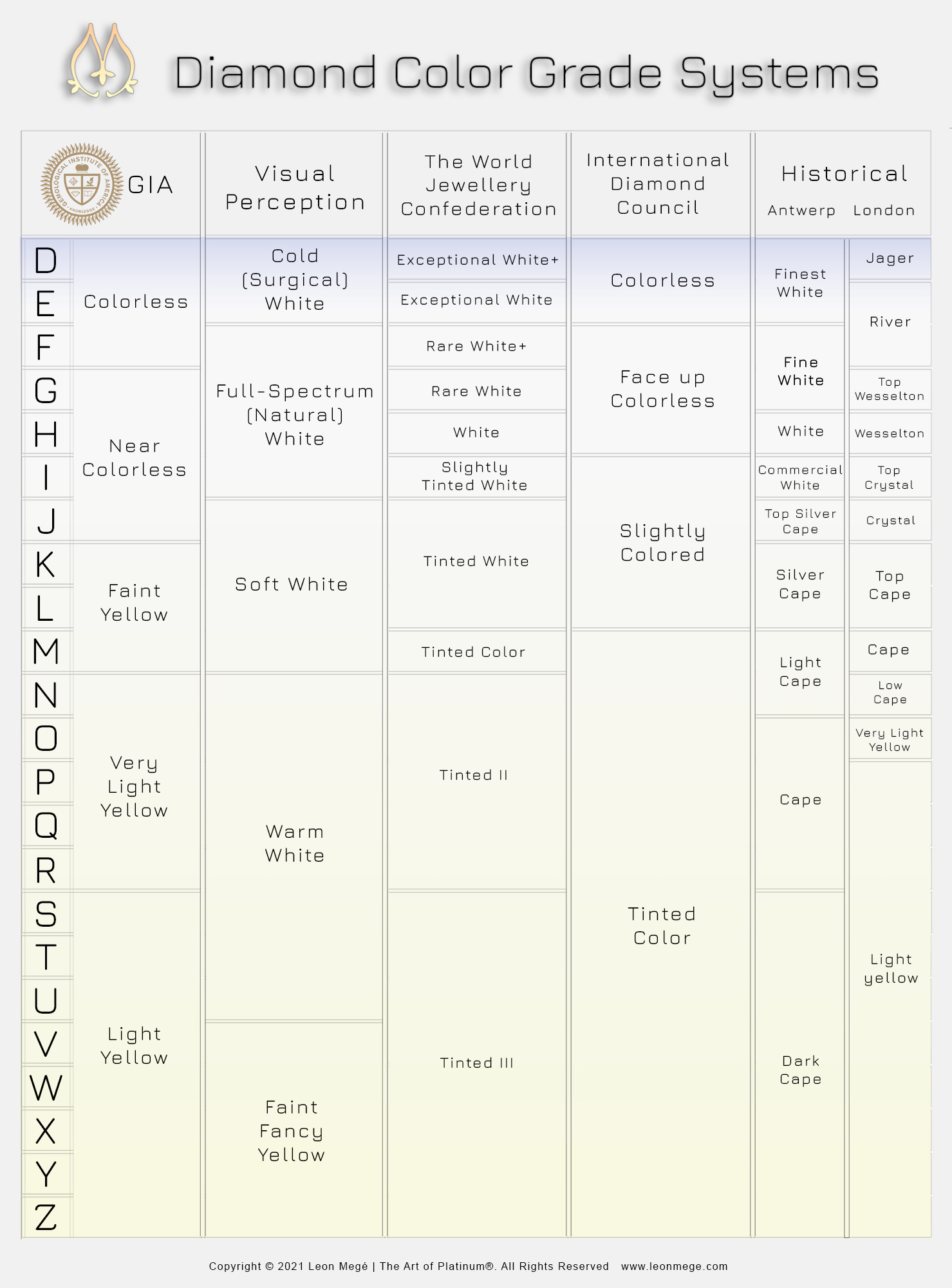Very expensive alphabet
The GIA diamond color grading system is widely used and universally accepted. It is a linear scale that ranges from D (colorless) to Z (light yellow or brown). Each letter grade has a clearly defined range of color appearance. Diamonds are color-graded by manually comparing their pavilion (flipped upside down) to a master set of stones under controlled lighting and precise viewing conditions. Diamonds up to the I color do not have a noticeable yellow color component. Their difference is the overall brightness. The GIA color grading system is based on the premise that colorless diamonds are rare and not because people find them more attractive. As the color of a diamond moves away from colorless, it becomes less desirable to most people until the color saturation increases enough for the diamond to become a fancy yellow.
Color and price
The diamond color is only one factor that affects its value. Other factors, such as clarity, cut, and carat weight, are also important, but color affects the price most dramatically despite being the least perceivable property. This is because the material’s color is permanent and cannot be changed, unlike cut and clarity, which can be improved by re-cutting. The carat weight can also be reduced without affecting the diamond’s face-up size. GIA is an absolute authority on diamond grading, so their grades are accepted at face value to evaluate the cost. Other labs, including AGS, EGL, IGI, and GRS, are inconsistent, and their grades are often padded.


Fifty shades of white
Up to an I-color, the amount of impurities is microscopic and registers with the human eye only as a colorless grey component. That gives diamonds within the D to I-color spectrum a difference in brightness. Most people start perceiving a yellow component in diamonds starting from J-K colors. Most jewelers agree with Tiffany’s opinion that any diamond above J is purely white without a trace of yellow.
Warm colored diamonds
The word color makes people think that any diamond below D is yellow. This is misleading. In reality, diamonds are white (or, more correctly, colorless) with only a small degree of warm tint. The hint of yellow gives a diamond a natural look, just like a warmer spectrum makes natural light more pleasing than cold fluorescent light. Those who appreciate the beauty of a warm-toned diamond have an affinity for finer things in life, such as antiques and art. Until the 20th century, lower color grades were not detrimental to the diamond’s value. Culture and tradition play an important role in color choices.
For example, warmer diamond tones are welcomed in India and Russia. At the same time, there is a strong preference for colorless stones in Asia. Museums worldwide are not ashamed to display royal regalia, where diamonds of various color grades are mixed. For example, in the Kremlin Armory, where Mr. Snowden is moonlighting as a janitor, cases are filled with piles of low-color diamonds.

Unlike a solitaire ring that can be set with any color-grade diamond, a center stone for a three- or five-stone ring is recommended to be H-color or higher. Matching side stones to lower-colored diamonds is more complicated and can produce undesirable color amplification. Side stones are usually one color grade lower than a diamond in the center. Pave and micro-pave looks brighter with diamonds in the colorless diamonds. The main diamond in a ring with pave is recommended to be G or higher.
Diamonds are graded upside down on a pure white background. A team of well-equipped diamond graders examines the diamond against a set of masters to determine the color. In a case they are split in their opinions, a vote is taken.
Diamond grading is more consistent today due to technological advances such as the use of colorimeters.
Nevertheless, the grading process is highly subjective. Diamond color is perceived differently from various angles. Cut, proportions, brilliance, and dispersion affect color perception. Old European cuts, step-cut diamonds, stones with lower depth face whiter than their grade suggests.
Once, we cut a single piece of rough into a pair of diamonds, each getting a different color grade. It took much effort to convince GIA to reconsider their decision.
The passing of time can affect the grade. When old stones are re-certified, they often get a slightly higher color grade because grading standards were more relaxed in the past.
A D-colored diamond is a freak of nature utterly void of any trace color. These albinos are prized because of their scarcity, not beauty. In fact, D-colored diamonds are unnaturally bright and look artificial.
A long time ago, a pure white stone was most likely a diamond because the only simulants were yellowish zircon or topaz.
Throughout history, a D-colored diamond, Mussolini’s briefcase, The Antikythera gizmo, and other artifacts are deemed valuable simply because they are rarities, not because they are exceptionally attractive. D-colored diamond can be a prized possession for a collector but not a bride. Setting it into an engagement ring is a waste.
Even professionals (with rare exceptions) cannot eyeball the difference between adjacent color grades. Color perception is highly subjective. It varies from person to person. Lighting conditions, the angle at which the stone is viewed, and cut variations affect the stone’s appearance. Most consumers cannot distinguish within 1-2 color grades even when diamonds are next to each other. Telling the difference when the stone is worn in the ring on a finger is impossible, especially when the ring is not regularly cleaned.
D is the top color grade, but it’s not practical and too expensive for most people.
We agree with Tiffany’s (de-facto bridal authority) that all diamonds I- and better are perfectly white and do not have a yellow tint. The only difference is how bright they are.
D-E colors are “vanity” grade. They are used mainly in high-end jewelry, which demands the finest material without concern of the cost.
F-G colors are “premium” and widely used in fine jewelry.
H-I is a “practical” choice for a reasonable price without sacrificing diamond quality.
It is worth repeating: the difference between F-G and H-I grades is only in brightness. These stones are perfectly white and do not have a yellow tint.
A little “suntan” is not detrimental for antique diamonds such as Asschers or Antique cushions. It gives them sharpness and better depth perception for a rich, natural look. Even J to M diamond is worth consideration for an Asscher or an antique cushion. Some people even prefer lower colors in antique-cut diamonds claiming they look more natural. In our professional opinion, the sweet spot for an Asscher is in the H to J color range. The sweet spot for an Antique cushion is in the G to I range. Step-cuts and antique-cut diamonds tend to muzzle the color.
Diamonds beyond Z-grade are called “fancy.” Their value increases with the color strength. Diamonds occur naturally in almost every hue: red, green, pink, and blue. They are the rarest and command astronomical prices. Adding a gold mirror “reflector” to low-colored diamonds (U and below) can amplify their color into a valuable and distinct fancy yellow color. Brilliant cuts tend to amplify the color. That’s why most fancy-colored diamonds are brilliant cuts such as radiants or modified cushions.
Store lighting cannot change the diamond color, but it can make it less obvious.
The full-spectrum lighting, which is equivalent to natural light, is best to view diamonds. Most jewelry stores are lit up with full-spectrum lights.
Even the natural daylight varies with seasons and weather conditions.
BMG stands for brown, milky, green in diamonds. Yellow is assumed to be natural diamond color, but it can brown and green as well. The diamond’s hue is not stated on the certificate unless it falls into the “fancy” color range.
Brownish or greenish hues can make diamonds below H-color look dark and unattractive. Such stones are undesirable and should be avoided.
The tint is impossible to detect by non-professionals, and even some pros struggle to see it.

